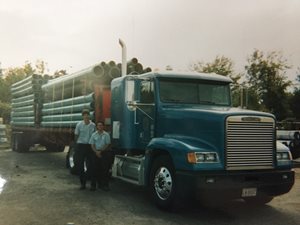.jpg.aspx?lang=en-US&width=300&height=225)

Fuel efficiency has been a major focus of mine since 1994. The reason I say 1994, is because that was two years before I purchased my own truck. That year, I was given the opportunity to spec out a truck for the private carrier where I was employed. It was at this point that I had begun planning the start of Albert Transport. Working at Grinnell Supply Sales helped me in many ways. I was sort of in charge of the two straight trucks and the one tractor trailer that we operated at this facility. There were many insightful lessons learned while working at Grinnell. Everything from customer relationships, route planning, truck maintenance, fuel taxes, truck registrations, and record keeping fell into my lap. There were three reasons for this:
- Trucking had never been a core of their business in the past
- No one else wanted to do it
- I had some past experience from my previous employment
This worked out great for me as I was wanting to learn more and I was using each one of these lessons as if I were running my own business.
When we decided to quit renting tractors and permanently lease a truck, I was given the responsibility of picking the new truck's specifications. I had enough respect from our branch manager that I could've chosen almost any power train within reason and not be questioned. I did not take advantage of this. I saw the opportunity as a chance to see how efficient of a truck I could put together. With the help of the local Penske location, I worked with our account manager to put together an efficient list of components that would make up our new truck.
When I think of the specs from back then and compare them to today's... my! They sure have changed!
This truck was primarily going to be used for delivering pipe and fire hydrants to fire sprinkler contractors and job sites. A lot of the routes would be local to the Charlotte, NC area, which also included trips up to the mountains, foothills, and the piedmont. There needed to be ground clearance for the job sites, so we started out with 11R 22.5 tires, followed by a 4.11 rear axle ratio, 10 speed Eaton Road Ranger overdrive transmission attached to a Detroit 12.7 Series 60 360 / 400 HP / 1,450 FPT engine. A lot of these specifications may seem odd, but working with the sales team at Penske, we decided that for our operation, this combination in a 1994 Freightliner FLD 120 48” sleeper would yield the best results possible.
Our speed was limited to 65 MPH and the end result was a truck that consistently averaged right below, or right above, the 8 MPG mark.
I was very impressed at how well this truck operated when all the proper pieces to the efficiency puzzle fit together and performed flawlessly. I still remember other people telling me to get a bigger engine. I received many other suggestions that would have put a dent in the efficiency that this truck was able to produce. In fact, I used many of the same parts and pieces when I put together my first, very own truck. There were some modifications because my operation was going to be less job site and more OTR, along with being loaded inbound and outbound.
In future blogs, I’m going to retrace my journey of efficiency since starting my own trucking business. Follow us at https://www.teamrunsmart.com/ and subscribe to our Youtube Channel.